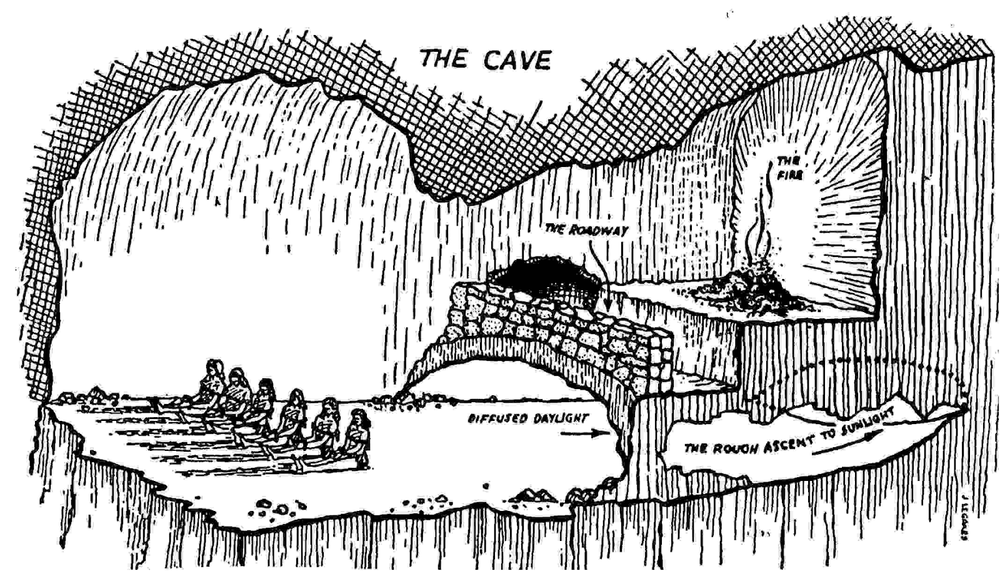For many of us, Plato’s The Republic, written around 375 BC, was required reading in high school or college. Through Socratic dialogue, he contemplates questions of politics, governance, justice, and ethics. There are many lessons that, for centuries, leaders have taken from the book and used as guideposts for their leadership philosophy. My favorite lesson, though, is not from the conclusions he draws on city-states and justice, per se, but rather from his argument on awareness, known as The Allegory of the Cave and told by Socrates, Plato’s teacher, to Glaucon, Plato’s older brother.
The Allegory of the Cave

For the prisoners, the shadows on the wall are their only reality. The prisoners do talk among themselves, naming the shadow figures they see. If they see the shadow of a sword on the wall, they may also call it a “sword,” picking up on the language used by the passers-by. But the object they’re calling a “sword” is, of course, not a true sword; it is only what they consider to be a “sword”—that is, the shadow of the real sword. The prisoners also identify the voices of the figures that pass regularly, linking the shape of each shadow and gait of each walk to the sounds of the accompanying voice. In fact, the prisoners can not only recognize the figures but also categorize them by job, based on the objects they carry and what they discuss. They can surmise the entire hierarchies of human dynamics and understanding. In this reality, the prisoners’ perception of the world is certainly false, but completely based on the truth of what they can see, hear, perceive, and understand.
Plato continues to write that one prisoner is then freed from his shackles. The prisoner stands up, turns his head to the side and sees other prisoners, and then turns his head around to see the fire, the sight of which sears his eyes. As his eyes adjust to the light, he begins to lose sight of the shadows on the wall. At some point, he will deduce that reality as he knew it, made up of the shadows and voices, was just an illusion. He will see both the people with their three-dimensional objects and the projections of them on the wall.
The man exits the cave and experiences sunlight for the first time. Initially, he is blinded, only able to make out shadows around him. But slowly, reflections of objects in water come into view. He then sees the objects outside in their true form. He sees the moon and the stars and, finally, the sun. Enveloped in the brightness of reality, he remembers his old living quarters and pities the other inmates. He eventually returns to the cave to share with the prisoners the wonders above—the true reality—calling for them to cast aside their games of naming, categorizing, and understanding the shadows. In fact, he can no longer see the shadows clearly anymore, for his eyes have adjusted to the light, and he seems to lose his understanding of the reality of those in the cave. The prisoners, without knowing what he now knows of the outside, mock him for his foolishness in leaving the cave, convinced that it damaged his eyesight. Not wanting to lose their own sight, the prisoners conclude that they should stay in the cave, keeping their perception of reality.
The argument for awareness
Plato argues that the sun is reality and truth and that, with its light, one gains intellectual thought and knowledge. A person in the cave has limited senses, thus giving them an incomplete understanding of reality. Therefore, awareness comes about by exiting the cave, as exemplified when the formerly imprisoned man slowly regains his senses and, with sunlight shedding both literal and metaphorical light on the world, comes to grasp its true workings: There are humans, 3D objects, lakes, a sky, stars, and even a sun. With the prisoner’s return to the cave, Plato’s argument goes one step further, positing that we have a natural desire to share awareness (at least his understanding of awareness) with others.
My take on Plato’s work, however, is not awareness as knowledge, but awareness in another form: perspective. All too often we are caught up in our daily lives, living inside our heads, playing out scenarios that don’t exist, rushing in a hurried frenzy to get to our next destination. We are angered by the tenacious drivers that cut us off in traffic. We become depressed when we do not get the promotion we wanted. We snicker with joy when we hear about our rivals misstepping. We tell ourselves we are better, smarter, more hard-working, and more deserving than others. We continue to follow the standard, presupposed script of life from our typically closed perspective.
In the allegory, it’s not that the newly aware prisoner is now smarter than his comrades in the cave. It’s simply that his perspective has changed. Ideas of life as he knew it were thrown out. And because of it, he is able to live a fuller life—out of the shadows.
Perspective shift
I often think of this allegory when reflecting on my career thus far. I spent many a year in the cave, not knowing that I was only seeing and only focusing on a small portion of the world around me. In the early stages of my company, like many founders and early employees, I got so “in the zone.” And being in the zone feels really good. You feel a strong sense of intuition and often act and react to your internal gut feelings. You see all the positive signals that show you’re on the right track. Being in the zone also adds a lot of confirmation bias, and like the prisoners in the cave watching the shadows, you see what you want to see.
At a certain point in my experience, though, the shadows started getting foggy—or maybe the fire at my back was starting to burn. The amount of tremendous focus and in-the-zone tunnel vision had created a myopic view of everything else—what was going on with my body, with my mental health, with my relationships and our families. Realizing that I was no longer in touch with all of these other things shifted my perspective: What if this “known good”—the intuitive, laser-focused, in-the-zone work habit—actually wasn’t good? What if it was actually proving detrimental to myself, my loved ones, and, in fact, my company and team? Now, that was a scary thought. And that’s why we don’t often want to change our perspective to begin with—it’s scary. It activates all of our well-entrenched fears. It is difficult to admit when you’re wrong, and it’s difficult to see that it may be your own ego keeping you trapped in the cave.
But on the other side of those fears is usually freedom. When we just stick to the presupposed founder trajectory and work habits, to keep unhelpful (or even stereotypical) thought patterns, we imprison ourselves and our growth and that of those we’re leading. New perspectives—even and especially perspectives that show us where we’re failing ourselves and others—bring with them the freedom to change and make new choices. To actually learn from others and ultimately lead with broader understanding and much, much more humility.
Stepping out of our caves
Now, we don’t all have literal caves to step out of and gain new perspectives from. But we do all have things we see as mere shadows—people and groups we fail to see as three-dimensional, and pieces of ourselves we fail to recognize with full honesty. In that way, we all have our own versions of the cave at all times, myself included, no matter how much progress we’ve made in cultivating awareness. Because in truth, there are more unknown unknowns in this universe than anything else. Issac Newton once said, “What we know is a drop, what we don’t know is an ocean.” Even human experience itself—molded by our senses, our thoughts, our feelings—is not a true representation of reality. We’re merely interpreting the world through the filters of our own awareness.
In my own founder journey, I try to remember this: What got me to where I am today isn’t necessarily what will get me to the next level.
I’m in a cave right now. So are you. And so are all founders. The real founder journey is a constant process of cultivating our continued awareness towards what we need, what our business needs, what our team, customers, and investors need. Leading with an attitude of continuous improvement, continuous awareness, and continuous learning is the compound interest that breaks us out of each cave and into the light. A little Plato helps, too.
Love what you’re reading? Subscribe to our newsletter and never miss out on our latest posts.







